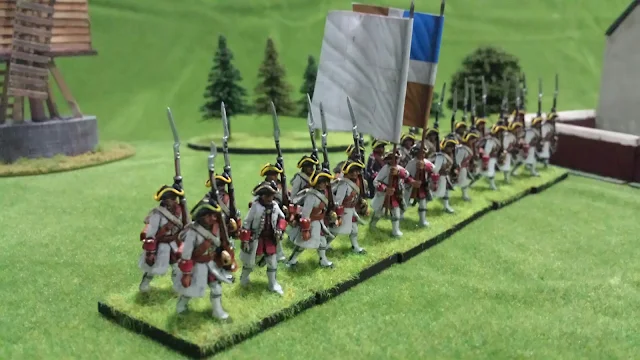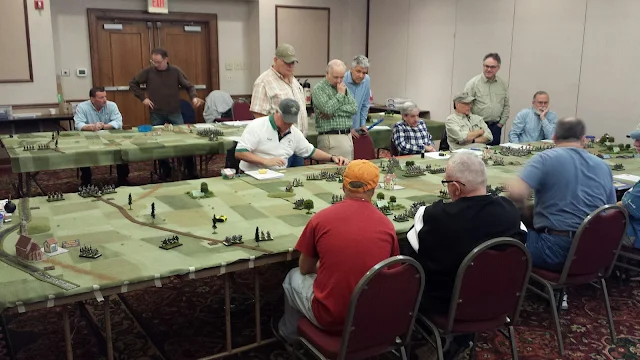Monday, October 23, 2017
Royal Ecossais 1745
In the pages of the Fife and Drum forum was where I first saw pictures of the figures for this regiment. They were very different and had a air about them. The short coats and bonnets are Scottish, but there is also something French about them. So with my first order I made sure I got a regiment.
My reading about their history suggests the uniform was what might have been worn when they landed in Scotland to assist in the 1745 Rebellion. Along with the picqets from the Irish Brigade they were the token effort sent by France to help out. At Culloden they covered the retreat of the Jacobite right wing from the battle.
Figures are from Crann Tara miniatures. Flag from GMB design.
Sunday, October 22, 2017
Regiment Orleans 1745
I have made great progress on my project of painting a mid eighteenth century army to refight the table top teasers and other actions from the books of Charles Grant both father and son. Since starting the project I now have four infantry regiments finished and two more primed and readying go. I am looking at a small army of eight regiments line, there cavalry and two guns for each side to start. Where it goes from there who knows!
I picked the era of 1745, The War of Austrian Succession for the slightly different uniforms, the interesting history and for the outstanding figures offered by Graham at Crann Tara miniatures.
The first of my regiments for my mid eighteenth century project is the Regiment Orleans. I know very little about The actual regiment but liked the red cuffs contrasted in the white coats. Not sure I got the correct white painting method for the uniforms yet. But out looks nice and it's a start. Figures are from Crann Tara. Flags from GMB
Saturday, October 21, 2017
An Saturday afternoon playing toy soldiers
I as extremely lucky to be a part of a true miniature wargame experience. Ed, from Ed M's Wargaming Means a blog put on a amazing game. It was a massive Napoleonic game, French vs Prussians. It was fought over a main table of 20' with two similar size tables for the match on area. So troops could be deployed and moved off table before marching into the main table. Very ingenious. To assist commanders looking across the room at the enemy armies Ed provided miniature telescopes!
Great fun trying to ID what those troops entering the table could be.
Both Ed
http://edmwargamemeanderings.blogspot.com
and AJ
http://ajs-wargaming.blogspot.com/2017/10/northern-conspiracy-october-2017-game.html
blogs provided outstanding reviews of the great battle. Since I was a lowly brigade commander i was lost in the middle of the table and honesty cannot tell you what was happening around me. Fog of war indeed.
Again many thanks to Ed for the great amount of work he put into this game and the incredible experience he provided to us all. Thank you Ed!
Friday, October 20, 2017
CURTISS P-40B TOMAHAWK at ORH
I was leaving work at Worcester Airport (ORH) when I noticed another aircraft from The Collins Foundation parked by The hangers. The story about The plane is fascinating.
The text is from The Collins Foundation website
at http://www.collingsfoundation.org/aircrafts/curtiss-p-40b-tomahawk/
The P-40 was the third-most numerous US fighter of World War II. An early prototype version of the P-40 was the first American fighter capable of speeds greater than 300 mph.
Thanks to a very generous sponsor, the world’s only P-40B and only surviving airworthy American fighter from the Japanese attack on Pearl Harbor joined the Collings Foundation.
One of the 131 P-40Bs built at the Curtiss facility in Buffalo, New York during 1940-1941 and allocated the Bu No. 41-13297, this fighter was delivered to the US Army Air Corp in March 1941. It was quickly sent to Wheeler Field, Hawaii in April of that year, becoming part of the 19th Pursuit Squadron of the 18th Pursuit Group. In October 1941, seven months after delivery, this P-40 was involved in a wheels-up landing, requiring her to be placed in a maintenance hangar for repair.
This aircraft was still in the hanger undergoing repairs when the Japanese attacked Pearl Harbor on December 7, 1941. That seemingly minor twist of fate most likely saved P-40B 41-13297 from being destroyed. Following repairs it was returned to flight worthy status. Then, on January 24, 1942, in another ironic twist of fate, with only nine months of service and 56 hours of flight time, while on a routine training flight the plane spun out of control. The pilot, Lt. Kenneth Wayne Sprankle, was unable to recover from the spin, crashing into the side of a mountain, killing him. The crash occurred in a rather inaccessible area of the island. So, after recovery of the body the aircraft was left in place.
In 1985 the Tomahawk’s remains were ‘rediscovered.’ After some preliminary investigation, it was determined the air frame was not severely damaged and if it could be removed was restorable. Some parts were recovered during 1985. A second recovery mission in 1989 salvaged the rest of the air frame.
In 1989, the Curtiss Wright Historical Association in Torrance, California was formed and serious restoration of the recovered P-40 began. The restoration was named “Project Tomahawk.” Whenever possible parts indigenous to the plane were used. Two other P-40B’s, the 39-285 that also crashed in Hawaii in 1941 and 39-287, that went down in a severe storm over the Sierra Nevadas October 24, 1941 were utilized for parts. When completed, the Tomahawk eventually joined “The Fighter Collection” at Duxford (UK) in 2003. P-40B Tomahawk 41-13297 flies wearing the scheme she wore during her time in
Hawaii with the 18th Pursuit Group.
Hawaii with the 18th Pursuit Group.
Thursday, October 12, 2017
American fleet
 |
| Iowa and Oregon |
 |
| Olympia, Baltimore and Boston |
 |
| Baltimore and Boston |
 |
| USS Brooklyn |
 |
| Olympia, Baltimore and Boston |
A nice collection of ships. But not enough to recreate the historical battles. This is not a problem as the battles were so one sided a more interesting table top action would be "what if" battles.
Historical note; I painted them in their peace time colors rather then the gray battle colors. Not correct, but they look so much nicer this way. I have the Gloucester done but not based for pictures.
Tuesday, October 10, 2017
Spanish fleet
Poor Spain, so far from God and so close to the United States....
The Spanish navy at the time of the Spanish American war was a mixture of the old and the new. Masts and wooden walls mixed with modern guns and steam. But maintenance was at a low point, and too many ships could not sail or had working guns. A shame as they were beautiful. when going into battle woodwork was not removed so splinters were a terrible problem.
My Spanish ships are a mixture from both naval battles of the war; Saintiago and Manila bay. Unfortunately I do not have all the ships to refight those battles, just most. But "what if" actions are more interesting food this period.
Friday, October 6, 2017
Only one tiny little ship....
 |
| The USS Maine |
Sometimes we start projects because they are important to us. But too often we start projects because ..... Here is a rediscovery of a project from right years ago.
This was one of my weaker moments. As readers of this blog know I have a long held interest in the ill fated U.S.S. Maine. So years ago when I found the 1:1000 scale models of the Spanish American war period ships by Richard Houston I was besides myself. I just need one ship, that's all just one ship. With similar words we start down the path of madness.....
Well I went and ordered the Maine. It was a great model and fun to assemble and paint. But it looked so alone all by itself. Then I found out Richard Houston had retired and was no longer selling the ships.
So when I found on eBay someone who was selling a big bunch of them I jumped at the chance. I spent like a drunken sailor and bought bunches of Spanish and American ships. Soon I had painted fleets which to do battle with. But then, I found out about naval rules. Very complicated, lots of numbers and calculations. Many die rolls for each gun to see if you ranged in, hit the target and then if you caused any damage. What was worse, the battles between my fleets were so lopsided. The Spanish ships were, how should I say less then second class compared to the new state of the art American ships. So off they went into a box to disappear for the next eight years.
Since that time I had forgotten about the ships. Recently, in cleaning up I found them (along with a number of other forgotten projects). They do look nice, and perhaps there is a simple fun set of rules out there.....
To be continued......
Subscribe to:
Comments (Atom)

















